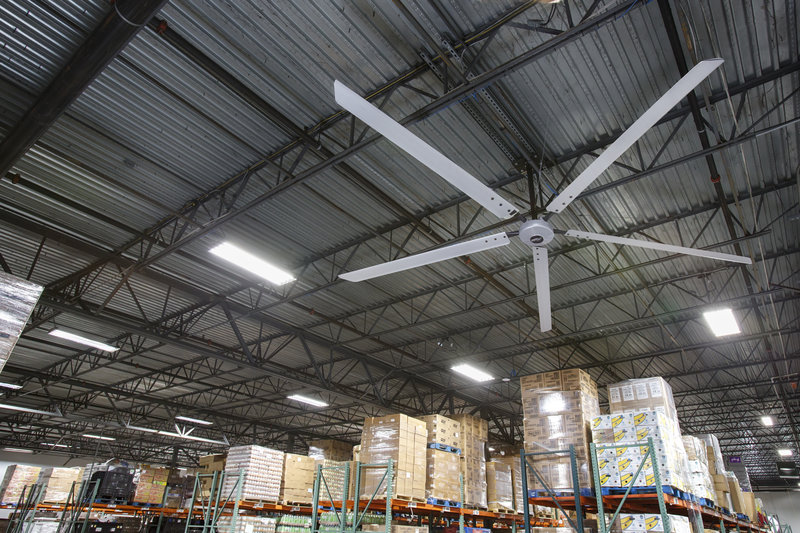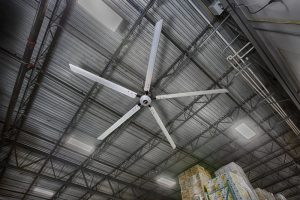How an HVLS Fan Will Enhance Your Manufacturing Facility

By Jeff Chastain, Hunter Industrial Senior Vice President & General Manager

Jeff Chastain
Your facility’s indoor air quality, in many ways, sets the tone for your workforce––from improving employee productivity to creating a safer working environment to streamlining energy efficiency.
In large facilities like industrial warehouses, manufacturing plants and distribution centers, managing this air quality can be challenging. While there are a number of conventional options—ranging from exhaust fans, HVAC units and high-speed floor fans to swamp coolers––these traditional routes often fail to provide comprehensive solutions. Conversely, high-volume, low-speed (HVLS) fans mobilize and de-stratify large volumes of air in a way that truly “clears the air” of any facility.
The Importance of Air Quality
The term “indoor air quality” refers to the air quality within and around buildings and structures, particularly relating to the health and comfort of building occupants. Poor air quality––which includes an excess of hot or cold air, indoor pollutants and stagnant air––can cause labored breathing and illness in employees while also posing product quality control risks such as condensation build up and spoilage.
In fact, the U.S. Department of Labor’s Occupational Safety and Health Administration (OSHA) highlighted these dangers in their heat safety campaign and winter weather advisory––linking cases of cold stress and heat exhaustion in employees to extreme air temperatures and/or humidity levels.
But it’s been proven you can improve air quality by simply improving air circulation. HVLS fans are particularly adept at this, providing large-scale airflow that regulates temperature while preventing stagnant air and a dust-riddled environment. High air turns also help eliminate toxic airborne chemicals. Additionally, HVLS fans can manage a facility’s moisture which can form on the walls and equipment in the plant or factory floor in between two different climate-controlled environments. Proper indoor air movement can quickly dry this condensation to reduce fall risks, pollutants and bacteria associated with unchecked moisture.
Under OSHA law, employers are responsible for eliminating these known safety hazards. With this in mind, making investments in environment-regulating solutions like HVLS fans is not only a benefit but a critical need.
The Temperature Difference

Hunter Industrial Fans 2017 Second Harvest
One customer in Nashville, Tenn. found themselves in this very scenario. Relying on pedestal fans to cool their unconditioned warehouse during the brutal Tennessee summer, relief was only provided to employees working within immediate vicinity of the fans. As a result, a facility manager became ill from the heat and was unable to return to work. During the hottest portion of the summer, the facility was forced to close its doors.
When two 14-foot HVLS fans were installed, they generated a consistent breeze throughout the warehouse and made an immediate difference for employees. Since then, the warehouse has remained open all year-long with an uninterrupted rate of productivity.
There is a misconception, however, that fans are only useful in the warmer months. One of the primary benefits of an HVLS fan is its ability to destratify an environment, evenly distributing air throughout a manufacturer’s building. During the winter, this ensures warm air is continually and equally dispersed––circulating warm air trapped at the ceiling down to the plant floor. This allows HVAC systems to work more efficiently and effectively, potentially saving up to 30 percent on heating costs.
Improving Comfort and Productivity
By creating a more comfortable, healthier work environment, we have seen companies experience reduced absenteeism and employee complaints coupled with boosts in overall productivity.
A 2014 study from the Indian Statistical Institute entitled “The Impact of Temperature on Productivity and Labor Supply: Evidence from Indian Manufacturing” echoed the point that labor productivity decreases in high temperature environments—with productivity reducing three percent per increase in one degree Celsius. The study also stated that “sustained heat may reduce worker attendance.”
One manufacturing and logistics company experienced improvements in workforce conditions and productivity after installing seven 24-foot HVLS fans in their unconditioned 300,000-square foot warehouse. Their previous cooling methods had included pedestal and barrel fans, which were both ineffective and inconvenient in a facility of its size. The company had also experimented with swamp coolers, but the resulting maintenance proved to be a headache.
They have since kept their HVLS fans running 24/7 to prevent the buildup of stagnant air and heat. In the words of the company’s Vice President of Supply Chain, “[HVLS] fans provide uniform comfort year-round for our nearly 230 employees, which has in turn increased worker productivity. After moving to our new facility and installing these industrial fans, we’ve received no employee complaints related to workplace comfort. They are essential in creating an optimal, healthy environment in our facility from ceiling to floor.”
HVLS Fans vs. Conventional Options
Having discussed the need for and benefit of HVLS installations, it may still leave the question––what really sets HVLS fans apart from conventional options?
Some of the key differentiators are the minimized energy consumption per square foot, the cost savings of about $1 per day to operate, as well as reduced noise. In addition, HVLS fans’ cordless design allows for a safer industrial environment, eliminating trip hazards––an important factor considering many plant and facility managers identify cords as one of the top workplace hazards. In fact, the overall direct interaction between an employee and a fan is virtually eliminated with many HVLS models. This feature is compounded by the maintenance-free aspect of those HVLS fans with direct drive motors, which also eliminate the risk of oil leaks posed by traditional gearbox motors.
But the primary distinguishers come down to enhanced coverage area and efficiency. One HVLS fan can replace as many as 10-20 floor flans or 12 48-inch barrel fans, effectively creating a 10- to 12-degree perceived temperature difference.
A Comprehensive Solution
Considering all these factors, HLVS fans are emerging as a comprehensive solution to improve energy savings, cost savings and workforce health and safety conditions across the board and across industries. Choosing the right HVLS solution can ultimately improve a manufacturer’s wellness standards while boosting their bottom line.
Learn more about choosing the right HVLS fan to revolutionize your indoor air quality at www.hunterfan.com/industrial













